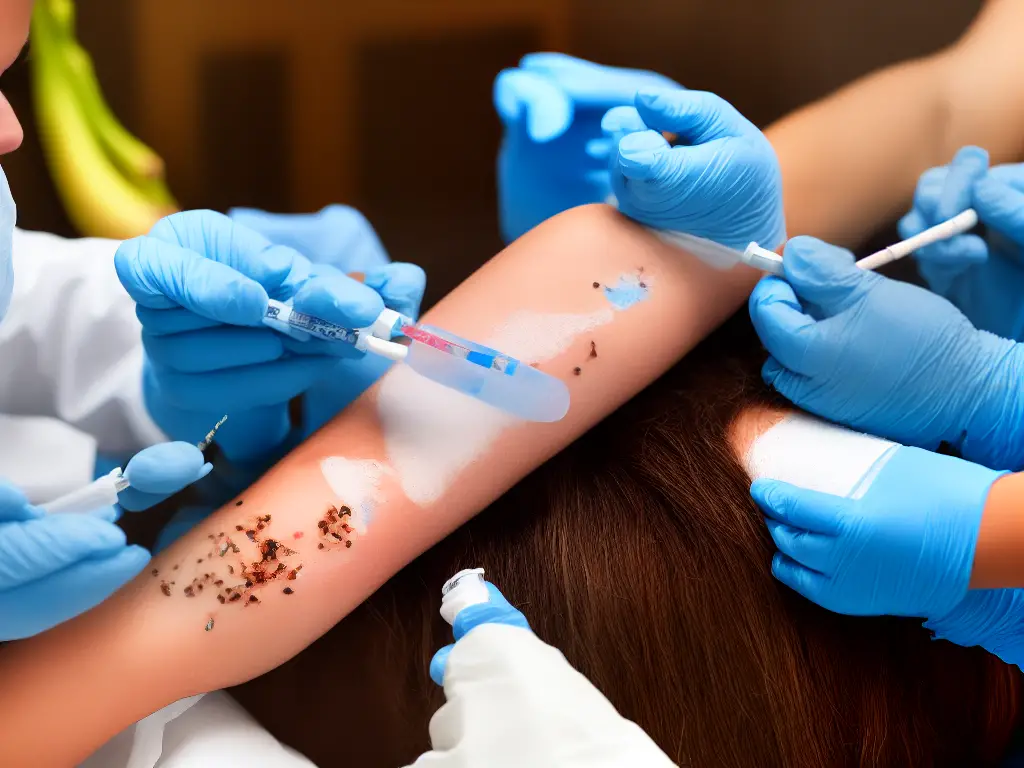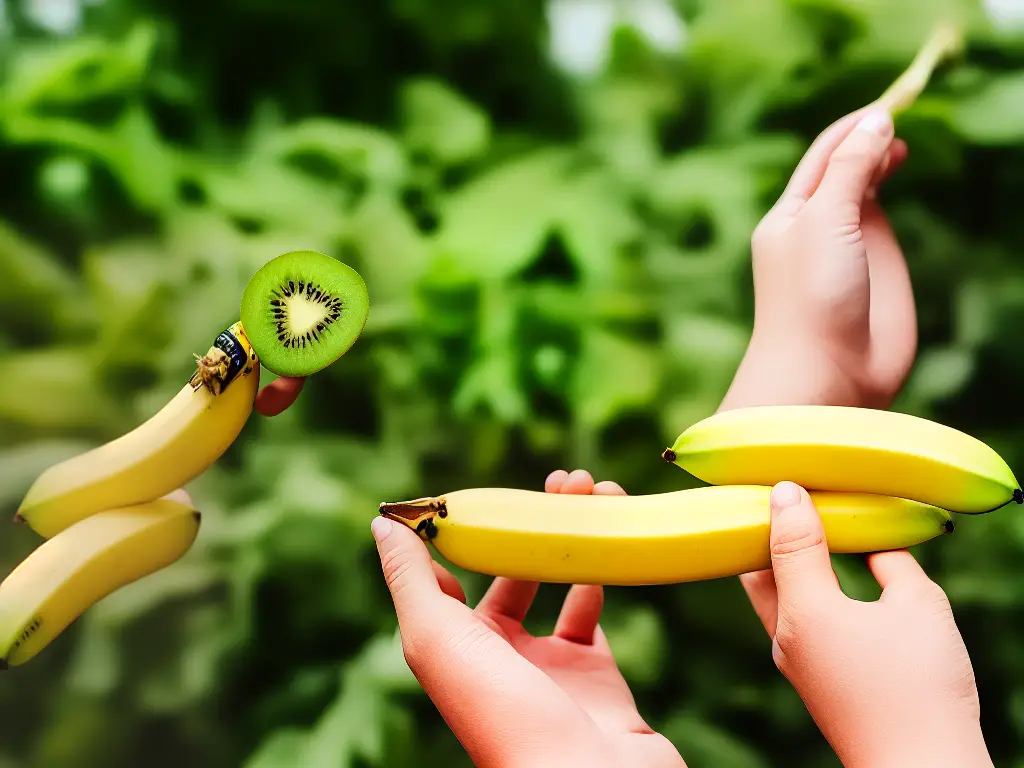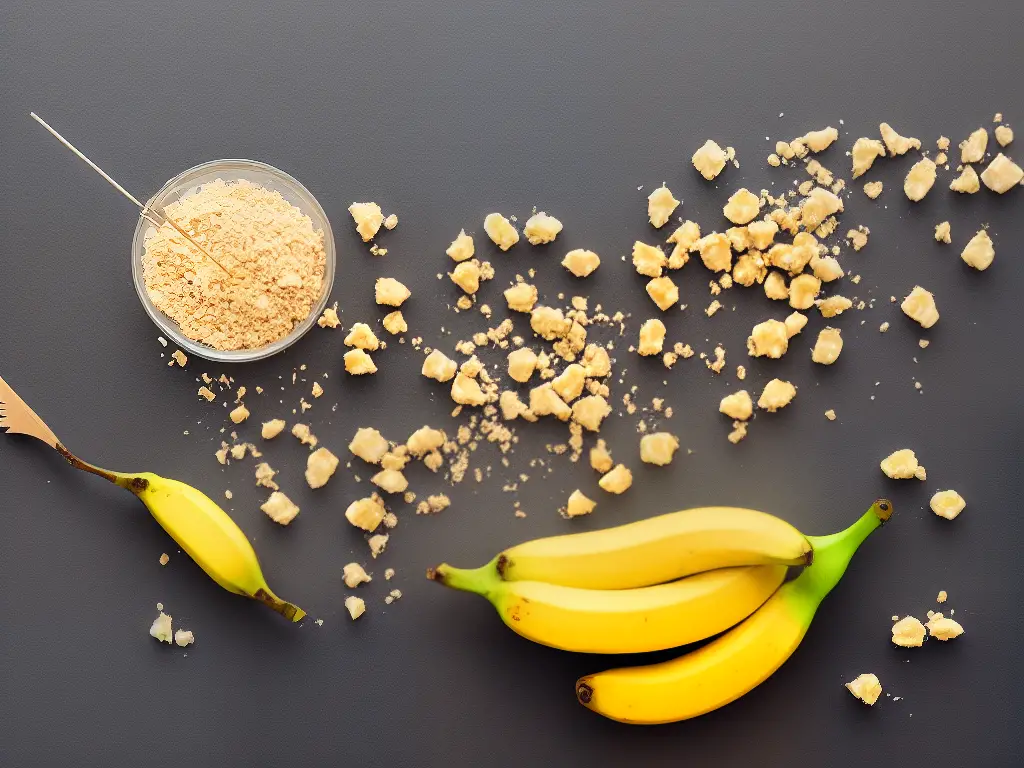Food allergies are a prevalent concern affecting individuals worldwide, significantly impacting their quality of life and daily choices. Among these is the lesser-known, yet still consequential, banana allergy. This essay delves into the intricacies of banana allergies, revealing their causes, symptoms, and prevalence, while also exploring the different types that individuals can experience. By understanding the process of diagnosing banana allergies and the various treatment methods available, individuals can confidently navigate their lives, even when faced with unexpected challenges.
Understanding Banana Allergies
Food allergies occur when the immune system mistakenly identifies a specific food, such as bananas, as harmful and launches an attack against it. The prevalence of food allergies is increasing and now affects around 8% of children and 5% of adults, although the reasons for this upturn remain uncertain. Food allergies can cause a range of symptoms, from mild to severe, including hives, swelling, difficulty breathing, abdominal pain, and vomiting. In severe cases, a life-threatening reaction called anaphylaxis can occur. The severity of the allergy varies among individuals and can even change in a person over time.
In order to better understand banana allergy, it is essential to differentiate it from food intolerances and sensitivities. Food allergies are immune system reactions, while food intolerance and sensitivity involve the digestive system. Food allergies can cause immediate and potentially dangerous symptoms, while intolerances and sensitivities may result in delayed, less severe, and more varied symptoms, such as bloating, gas, and diarrhea. For example, some people may have trouble digesting bananas due to a sensitivity, but this is not the same as an immune-mediated banana allergy.
A banana allergy is usually caused by proteins present in the fruit. In some cases, it can be due to pollen-food allergy syndrome, also known as oral allergy syndrome. This condition occurs mainly in people who are allergic to birch tree pollen and causes an allergic reaction after eating a banana. This happens because the proteins in bananas are similar in structure to the proteins found in birch pollen. The body’s immune system confuses the two, causing an allergic reaction. This syndrome is usually associated with localized symptoms such as itching, tingling, or swelling in the mouth and throat.
One tricky aspect of banana allergy is that it often coexists or is associated with other food allergies, especially those involving fruits and vegetables that are also in the latex family (called latex-fruit syndrome). For example, people who are allergic to latex may also have an allergic reaction to bananas, kiwi, avocados, or chestnuts. Cross-reactivity may also occur between different allergens. This means that if someone has a banana allergy, they may be at risk for developing an allergy to other foods such as melons, bell peppers, or even celery.
Banana allergy is a type of food allergy that occurs when your immune system mistakenly identifies certain proteins in bananas as harmful. Upon consumption of a banana, your immune system responds by producing antibodies, triggering a chain reaction that leads to the release of histamine and other chemicals, resulting in uncomfortable symptoms. Although rare, banana allergy affects individuals of different age groups and can be more common in people with other fruit or pollen allergies.

Banana Allergy: Symptoms, Causes, and Diagnosis
For diagnosis and management of banana allergy, it is essential to consult an allergist or immunologist who may recommend skin tests or blood tests to detect specific allergen antibodies. Once a banana allergy is confirmed, strict avoidance of banana-containing foods and products must be followed. In case of accidental exposure, mild symptoms can typically be treated with antihistamines, while more severe reactions may require the use of an epinephrine auto-injector. It is crucial for individuals with banana allergy to be vigilant about their food choices, read ingredient labels carefully, and be prepared to manage any accidental exposure.
There are two primary types of banana allergies that people experience. The first type, immediate hypersensitivity, refers to an allergic reaction that occurs rapidly, usually within minutes to an hour after consumption of a banana. Symptoms of immediate hypersensitivity may include itching or swelling of the lips, tongue or throat, hives, shortness of breath, or in severe cases, anaphylaxis. The second type of banana allergy is called delayed hypersensitivity, which is a less severe reaction, and usually takes longer for symptoms to manifest, often hours or days after exposure. This form of allergy typically causes skin issues, such as redness, swelling, and itching, known as contact dermatitis.
Several factors can contribute to the development of banana allergy. For some individuals, it is due to a phenomenon called the “oral allergy syndrome,” which arises from cross-reactivity between the proteins present in a banana and proteins found in certain pollens, such as birch or ragweed pollen. Individuals sensitive to these pollens may therefore be more susceptible to a banana allergy. Additionally, genetic predisposition, a personal or family history of allergies, or environmental factors like exposure to allergies in early childhood can increase the risk of developing banana allergy.
The prevalence of banana allergy varies across different populations, and its true rate remains uncertain. Some studies suggest that up to 1.3% of the general population may suffer from a banana allergy, while the prevalence is higher, around 2-7%, among those who are allergic to other fruits or pollen. Children tend to outgrow some food allergies, but banana allergy can persist into adulthood for some individuals.
A banana allergy is diagnosed through a series of tests conducted by an allergist, who begins by reviewing the patient’s medical history. These tests may include skin prick tests or blood tests to detect the presence of specific antibodies to the proteins found in bananas. In some cases, oral food challenges are performed under medical supervision to confirm the diagnosis. Once a banana allergy is confirmed, it’s essential for the individual to avoid bananas and any other identified trigger foods. Additionally, carrying an epinephrine auto-injector can be a lifesaving measure for those with immediate hypersensitivity reactions.

Understanding Banana Allergies
The immune system’s overreaction to proteins present in bananas causes banana allergy. Chitinase, one of these proteins, breaks down the cell walls of certain fungi. It is part of the PR (Pathogenesis-related) proteins family, which can be found in various fruits and vegetables. An allergic response occurs when some individuals’ immune systems mistakenly identify chitinase as a harmful substance. Understanding the cause of the allergy enables patients and medical professionals to more effectively manage the condition and minimize exposure to triggers.
Another protein associated with banana allergy is profilin, a component responsible for the structure and function of cells. Profilin is present not only in bananas but also in a variety of other plants. Similar to chitinase, profilin sometimes triggers the immune system to release histamine and other chemicals to fight off the perceived invader, resulting in allergy symptoms like itching, swelling, and congestion.
Cross-reactivity is a significant factor in banana allergies, as people who are allergic to bananas may also be allergic to other fruits or substances due to similarities in protein structures. For instance, individuals with a latex allergy might also have a banana allergy, as both substances contain similar proteins. This phenomenon, known as the latex-fruit syndrome, can also extend to other fruits and vegetables, such as avocados, kiwis, and tomatoes.
Pollen allergies can also correlate with banana allergies due to cross-reactivity. Ragweed, in particular, contains proteins similar in structure to those found in bananas. Thus, individuals with a ragweed allergy may experience oral allergy syndrome – an allergic reaction affecting the lips, mouth, and throat – when consuming bananas. Similarly, people with allergies to birch or grass pollens may be more likely to have a banana allergy.
Managing a banana allergy is crucial for general health, as some individuals may experience mild symptoms like itching or rashes, while others may face severe, life-threatening reactions like anaphylaxis. The key to preventing allergic reactions is to carefully read food labels and watch out for bananas or their proteins in unexpected products. Those with pollen or latex allergies should also be cautious when trying new fruits and vegetables that may share similar protein structures with bananas, in order to reduce the risk of a serious allergic reaction.

Diagnosing Banana Allergies
Diagnosing a banana allergy involves a combination of methods, including an assessment of medical history, skin-prick tests, blood tests, and oral food challenges. Based on a person’s reaction to bananas and their symptoms, which may include itching, swelling, hives, or gastrointestinal issues like nausea, stomach pain, or vomiting, medical professionals can determine if an allergy is present. If there is a suspicion of a banana allergy, further diagnostic tests may be recommended to confirm the diagnosis and ensure proper management of the condition.
Skin-prick tests are a common and non-invasive way to diagnose a banana allergy. During this test, a tiny amount of banana extract is introduced into the skin’s surface, usually on the forearm or back. The skin is then observed for any signs of an allergic reaction, such as redness, itching, or swelling. Small, controlled reactions can help determine the presence and severity of a potential allergy. A significant pro of the skin-prick test is that it produces results quickly, often within minutes to an hour. However, a con is that results can sometimes be inconclusive or false-positive due to other factors such as pollen-food syndrome (oral allergy syndrome).
Blood tests are another option for diagnosing banana allergy. This method involves measuring the levels of immunoglobulin E (IgE) antibodies in the blood. IgE antibodies are a specific type of immune system cell that triggers allergic reactions. Elevated levels of IgE antibodies suggest that the body is interpreting banana proteins as harmful, leading to an allergic response. Blood tests are useful for people who are unable to undergo skin-prick tests for any reason, and also provide a less reactive environment for the patient. However, blood tests may not be as fast or accurate as a skin-prick test.
Oral food challenges are a more direct approach to diagnosing banana allergies. During this test, a small amount of banana is given to the patient to consume under medical supervision. The dose is gradually increased, and any symptoms are closely monitored by a healthcare professional. If a reaction occurs, the test is halted, and appropriate medical intervention is provided. Oral food challenges are considered to be the most accurate form of allergy diagnosis, but they also carry the risk of causing a severe allergic reaction.
Diagnosing banana allergies involves various methods, each with its pros and cons. The most suitable option depends on an individual’s specific situation and medical history. A medical doctor, particularly an allergist, can guide patients towards the most appropriate method of diagnosis and help them understand the potential risks and benefits involved. Proper diagnosis of banana allergies enables individuals to manage their condition through avoidance, medication, or other necessary interventions.

Managing Banana Allergies
Managing and treating banana allergies, like other food allergies, demands careful attention and vigilance. The primary approach is to avoid bananas and banana-containing products, which involves reading product labels meticulously and being cognizant of potential cross-contamination in restaurants and food preparation areas. Furthermore, due to cross-reactivity, a phenomenon where similar proteins in different foods can trigger an allergic reaction, some individuals with banana allergies might also need to avoid other fruits such as kiwi, melon, and avocado.
In case of accidental ingestion of banana, it is crucial to have emergency treatment options available. Antihistamines can help to alleviate mild to moderate symptoms, which include itching, hives, or swelling. However, in the case of severe reactions, an epinephrine auto-injector (commonly known as an EpiPen) should be readily accessible. An EpiPen can be prescribed by a healthcare professional, and it is essential to carry this life-saving medication at all times, as severe allergic reactions can be life-threatening without prompt treatment.
Immunotherapy, or allergy shots, may be another suitable treatment option for some individuals with banana allergies. This process involves the administration of small amounts of the allergen, in this case, banana, to help the individual’s immune system gradually adapt to the allergen and reduce the severity of the allergic reactions over time. Immunotherapy is typically a long-term treatment, lasting several years, and must be supervised by a qualified healthcare professional. However, the effectiveness of immunotherapy for banana allergies is not yet fully established and may not be suitable for all affected individuals.
Seeking medical help when a reaction occurs is critical in managing banana allergy. Those with known allergies should have a personalized emergency action plan developed in consultation with their healthcare provider. This plan typically includes information on recognizing symptoms, first-line treatments, emergency contacts, and guidance on when to seek more advanced medical care following an allergic reaction. Regular check-ups with an allergist are also encouraged to monitor the progress of the allergy, assess treatment effectiveness, and modify the management plan if necessary.
Managing a banana allergy effectively involves careful avoidance, having emergency medications on hand, considering immunotherapy, and seeking medical help when necessary. Through a combination of these strategies, individuals with banana allergies can minimize their risk of experiencing severe allergic reactions and lead fulfilling lives with confidence in managing their allergy.

Alternative Nutrient Sources for Those with Banana Allergies
Adapting to a banana-free diet may initially seem challenging, but there are alternative food sources that can provide similar nutritional benefits. For instance, bananas are known for their potassium content, which is essential for maintaining healthy blood pressure and preventing heart disease. Other potassium-rich foods that can be incorporated into a balanced diet include avocados, spinach, sweet potatoes, and various types of beans. By including these alternatives in daily meals, individuals with banana allergies can still meet their potassium needs while avoiding bananas and enjoying a diverse range of foods.
Another nutrient found in bananas is vitamin B6, which plays a vital role in cognitive development, energy metabolism, and the formation of red blood cells. You can obtain adequate amounts of vitamin B6 from other foods such as salmon, chicken, potatoes, and chickpeas. Including these foods in your diet will contribute to the recommended daily intake of vitamin B6 without consuming bananas.
Bananas are also a good source of dietary fiber, which is essential for maintaining healthy digestion and regulating blood sugar levels. There are plenty of banana-free foods that are high in fiber, such as whole grains, legumes, berries, and vegetables like broccoli, carrots, and bell peppers. Consuming these foods will help ensure that you obtain the necessary fiber to support digestive health and prevent constipation, even if you cannot eat bananas.
In addition to these nutritional alternatives, there are plenty of fruits that provide similar taste and texture attributes to bananas, which may help satisfy cravings for the fruit. For example, mangoes, papayas, and apples are fruits that can be consumed as an alternative to bananas without risking an allergic reaction. These fruits also offer various health benefits and essential nutrients, making them suitable substitutes for those with a banana allergy.
Managing a banana allergy involves ensuring a balanced diet while avoiding foods that may trigger an allergic reaction. Fortified foods and supplements can play a significant role in providing essential vitamins and minerals that may be difficult to obtain from other sources, especially for individuals with allergies. Cereals, bread, and milk are examples of foods commonly fortified with these essential nutrients. In some cases, it might be necessary to consult a healthcare professional about the use of dietary supplements to ensure that all nutritional needs are met without the risk of triggering an allergic reaction.

Living with a Banana Allergy
Being well-informed about potential hidden sources of banana in various products is key to managing a banana allergy effectively. Many processed foods, such as granola bars, yogurt, and baked goods, may contain banana as an ingredient or flavoring agent. It is essential to familiarize yourself with alternative names for banana, including plantain, banana extract, and banana powder. This awareness should extend to food labels on both edible products and beverages such as smoothies and mixed drinks, and even in skincare products or cosmetics. When in doubt, proactively reach out to food manufacturers to obtain information about ingredients in their products, as labels may not always explicitly mention the presence of banana or its components.
Managing a banana allergy in social situations, such as dining out and attending parties, can be challenging but not insurmountable. When eating out at a restaurant, it’s important to inform the server or the chef about your allergy in detail so that they can assist you in finding dishes that are safe for you. They will be knowledgeable about the ingredients used in their dishes and might be able to exclude banana in specific meals, if necessary. Developing a rapport with your favorite restaurants and being a regular customer might make them more attentive to your needs.
Attending parties with a banana allergy can also be navigated appropriately with some preparation. Inform the party host about your allergy beforehand, and offer to bring a dish or snack that you know is safe for you to consume. This not only ensures that you have something you can eat but also helps educate others about food allergies in general. Another option is to eat before attending the party, so your primary focus won’t be on the food, and you can concentrate on enjoying the company and the event.
Cross-contamination and accidental exposures to banana allergens can still happen despite being careful with reading food labels and communicating your allergy in social settings. It is crucial to have a plan in place to manage any potential adverse reactions to banana. You can do this by making sure you carry an epinephrine auto-injector (such as an EpiPen) for emergency use and wear a medical alert bracelet that provides information about your allergy. Consult with an allergist to understand the best treatment options for your specific needs.
Living with a banana allergy can be challenging, but with a strong support system, it is possible to have enjoyable and safe experiences in daily life. This support system should include friends, family, teachers, and coworkers who understand your allergy and are willing to help when needed. It’s important to teach them to recognize the symptoms of an allergic reaction and how to administer an EpiPen in case of unexpected exposure. With careful planning, proper education, and support from loved ones, living with a banana allergy can be manageable and may even provide an opportunity to advocate for food allergy awareness.

Latex-Fruit Syndrome and Cross-Reactivity
One interesting aspect of banana allergies is the connection to latex-fruit syndrome, a type of hypersensitivity reaction experienced by some individuals with latex allergies. This syndrome is characterized by cross-reactivity between latex proteins and certain fruit proteins, including those in bananas. The immune system can mistake these fruit proteins as latex proteins due to their similar structures, leading to an allergic reaction. This occurs as the immune system produces IgE antibodies to fight against the perceived threat. IgE antibodies are typically produced in response to allergens, and their levels can increase in individuals with allergies. Understanding this relationship between bananas and latex can be helpful in managing a banana allergy and advocating for greater food allergy awareness.
The connection between banana allergy and latex allergy lies in the formation of IgE antibodies. When a person with a latex allergy is exposed to bananas, their immune system can mistakenly identify the banana proteins as harmful, similar to latex proteins. The immune system then produces IgE antibodies against the banana proteins, just as it would against latex proteins. This cross-reactivity between latex and bananas can lead to similar allergic reactions for both substances, with symptoms ranging from mild to severe.
In addition to bananas, several other fruits have been linked to latex-fruit syndrome due to their cross-reactivity with latex proteins. These fruits include avocado, kiwi, chestnut, papaya, and passion fruit. Individuals with latex allergy may also experience allergic reactions when consuming these fruits, as their proteins can trigger the immune system to produce IgE antibodies as well. It is important for people with latex allergies to be aware of the potential for cross-reactivity with these fruits and consult with an allergist or a doctor to determine the best course of action for their specific situation.
It is worth noting that not all individuals with latex allergy will necessarily experience a reaction when consuming bananas or other cross-reactive fruits. The severity of the reaction can also vary among individuals, with some experiencing only mild symptoms while others may have more severe or life-threatening reactions. Common symptoms of latex-fruit syndrome can include itching or swelling of the mouth and throat, hives, difficulty breathing, and gastrointestinal issues such as abdominal pain and diarrhea.
In conclusion, latex-fruit syndrome is a result of cross-reactivity between latex proteins and those found in certain fruits such as bananas. The immune system of individuals with latex allergy may produce IgE antibodies when exposed to banana proteins, leading to allergic reactions. Other fruits that can show similar cross-reactivity include avocado, kiwi, chestnut, papaya, and passion fruit. It is essential for individuals with latex allergies to be aware of this potential risk and consult with healthcare professionals before consuming these fruits to ensure their safety and well-being.

Ultimately, understanding and effectively managing a banana allergy is crucial for those affected by this condition, as well as for their friends and family, to prevent potential risks and maintain overall well-being. By learning about the fundamentals of banana allergies and latex-fruit syndrome, individuals can make informed decisions regarding their dietary and lifestyle choices. Through proper knowledge of diagnostic methods, treatment options, avoidance strategies, and nutritional alternatives, those with a banana allergy can continue to lead a fulfilling and health-conscious life.